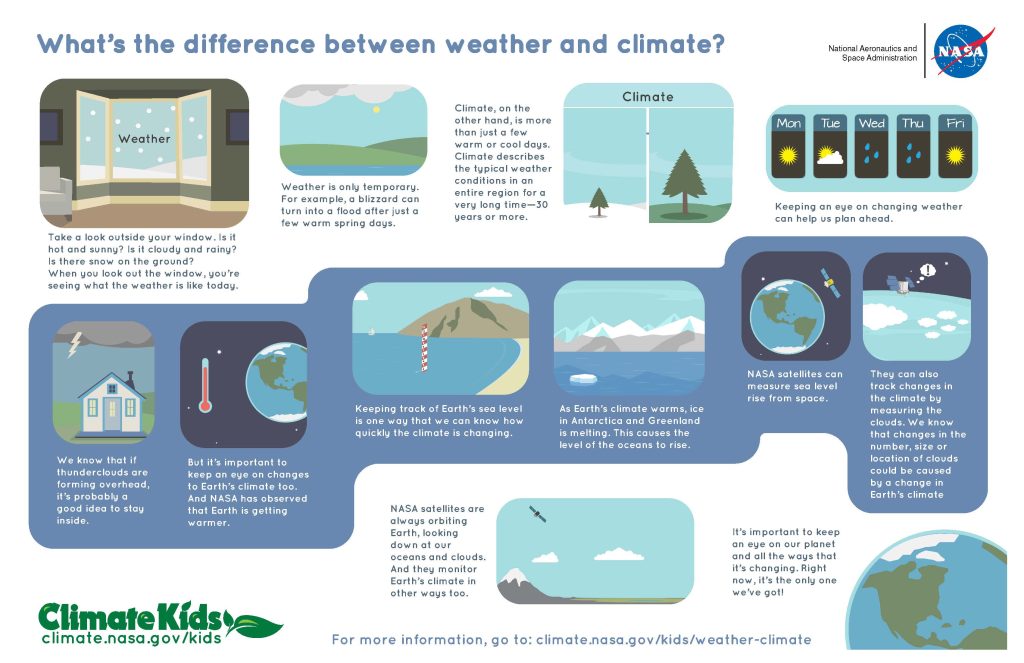Hello Avid Readers! This month I attended the Entomological Society of America annual meeting. There were many presentations that have me thinking about how climate change is likely to affect populations of many organisms, including pests, and how we manage them. It also got me thinking a lot about my day-to-day habits and how I can alter them to be more environmentally friendly. If you’re as curious as I was, read on to see where climate change and pesticides intersect.
What is Climate Change?
Climate change is modification of Earth’s climate due to changes in the atmosphere. It can be caused by natural or human activities, and it has various effects on Earth systems and life on Earth. According to NASA, scientists use observations from the ground, air, and space, along with computer models to study the past, present, and future climate. If you are curious about how this is done check out their page on Global Climate Change.
The changes that are happening now are noted most in atmospheric carbon dioxide, global temperatures, sea ice extent, and ice sheet volume. I did a search on Google Scholar (this is a database with peer-reviewed scientific publications) for “climate change pesticides” and got 1,180,000 results! The scientific community certainly has been investigating this topic heavily. I am a fast reader, but I couldn’t manage to get through all 2 million. I did my best to find out what things stood out and made some notes.

Pesticide Fate and Behavior
Climate change is anticipated to cause reduced pesticide efficacy (Matzrafi 2019). This may be due to a reduction in how much pesticide stays in the environment, or environmental concentrations of pesticides. Pesticide volatilization and accelerated degradation are both strongly affected by a high moisture content, elevated temperatures and direct exposure to sunlight. Considering this, pesticide persistence in the environment could change as some regions of the world become hotter and drier and others become more humid and rainy. Pesticide use might change based on the new environmental conditions (Delcour et al. 2014).
A reduction in pesticide residuals or efficacy, in the absence of novel pest management strategies, could lead to an increase in pesticide use. “An increased pesticide use is expected in form of higher amounts, doses, frequencies and different varieties or types of products applied” (Delcour et al. 2014). This could mean increases in non-target exposure or environmental contamination.

Agriculture and Human Health
As humans we can make our homes in many different habitats and tolerate changes in climate. Many other organisms are not so capable. Plants, animals, and even fungi often have a pretty limited range of what they can tolerate as far as temperature, humidity, and the composition of the other species around them. Let’s think about pests in agriculture as an example. If it were to get too wet for some weeds but not too wet for a crop that might not be so bad. However, since our agricultural systems are so heavily managed, often monocultures (one type of plant), and get many inputs that pests would also enjoy, it’s more likely pests will move in than be put out by climate change. Because of this and effects of climate change on pesticides, our food security may be in danger.
Like agricultural pests, changes in climate can alter habitat availability or cause areas that were previously uninhabitable to become suitable for vectors of disease. Disease vectors are likely to be managed in new areas by pesticides just as they are in their current ranges. This could mean new non-target effects as additional species are exposed to the applications. It may also mean the expansion of disease into areas where we were previously safe.

Occupational Exposure
Effects of climate change on pesticides will directly affect applicators. “Global warming, influencing the spatial and temporal distribution and proliferation of weeds, the impact of already present insect pests and pathogens and the introduction of new infesting species, could cause a changed use of pesticides in terms of higher amounts, doses and types of products applied, so influencing the human exposure to them during agricultural activities” (Gatto et al. 2016; Delcour et al. 2014). Since this is the case, those of us working with or near pesticides could be at higher risk of exposure in the future. Applicators should be aware of this potential outcome and prepare to protect themselves. Reading the label and wearing the designated Personal Protective Equipment (PPE) is an important safety practice. (And as Dr. Bultemeier would say, “The label is the law”.)
Summary
According to Dr. Suess, “Unless someone like you cares a whole awful lot nothing is going to get better. Its not.” Being aware of climate change and what causes it is step one. We know our fossil fuel emissions contribute to the levels of CO2 in the atmosphere. So, reducing our fossil fuel use is a great way to help prevent the outcomes listed above. Carpooling, being conscious about electricity use, and switching to non-plastic options are all ways we can contribute as individuals. Ultimately, it will be up to world governments and corporations to make changes large enough to solve the problem. As the effects of climate change are realized, pesticide applicators must be aware of what has changed. There may be label changes such as application rate or PPE required. Be aware and stay safe applicators!
References
Matzrafi, Maor. “Climate change exacerbates pest damage through reduced pesticide efficacy.” Pest management science 75.1 (2019): 9-13
Delcour, Ilse, Pieter Spanoghe, and Mieke Uyttendaele. “Literature review: Impact of climate change on pesticide use.” Food Research International 68 (2015): 7-15.
Gatto, Maria Pia, Renato Cabella, and Monica Gherardi. “Climate change: the potential impact on occupational exposure to pesticides.” Annali dell’Istituto superiore di sanita52.3 (2016): 374-385.
Click to Subscribe
 3
3
